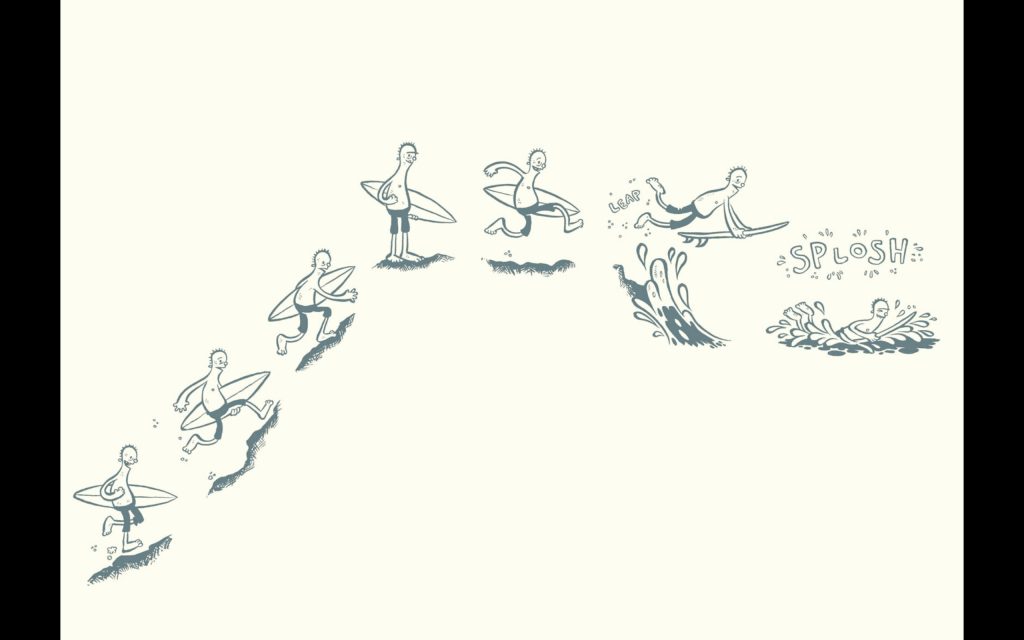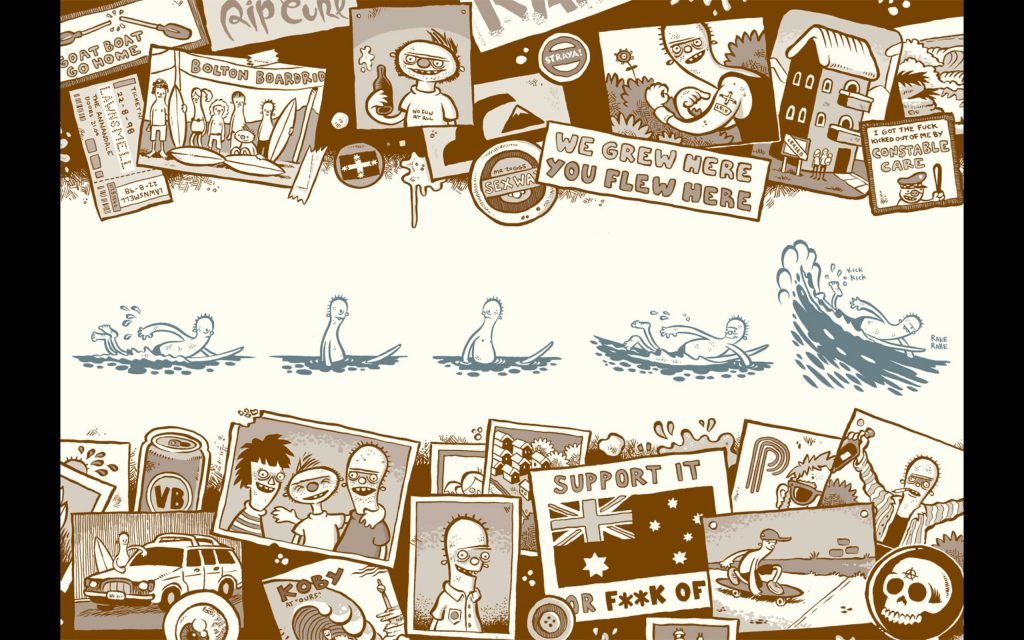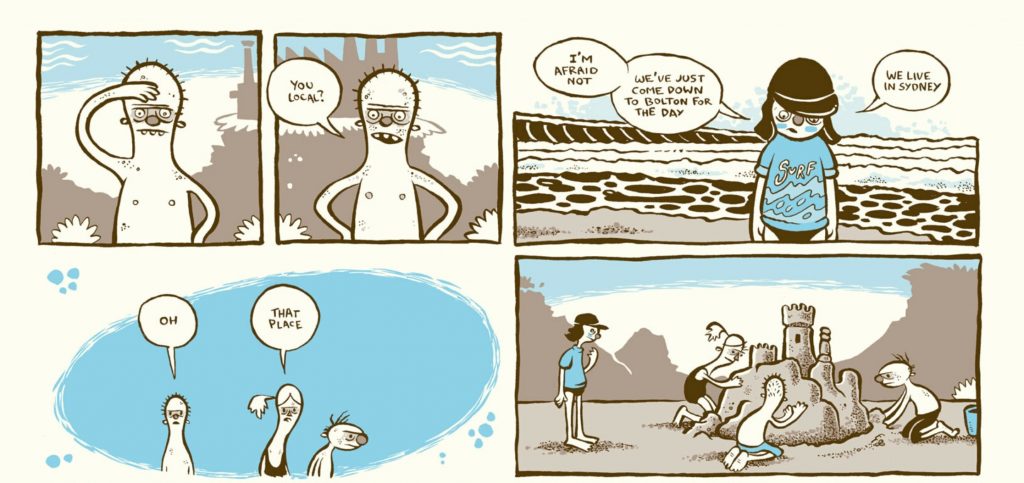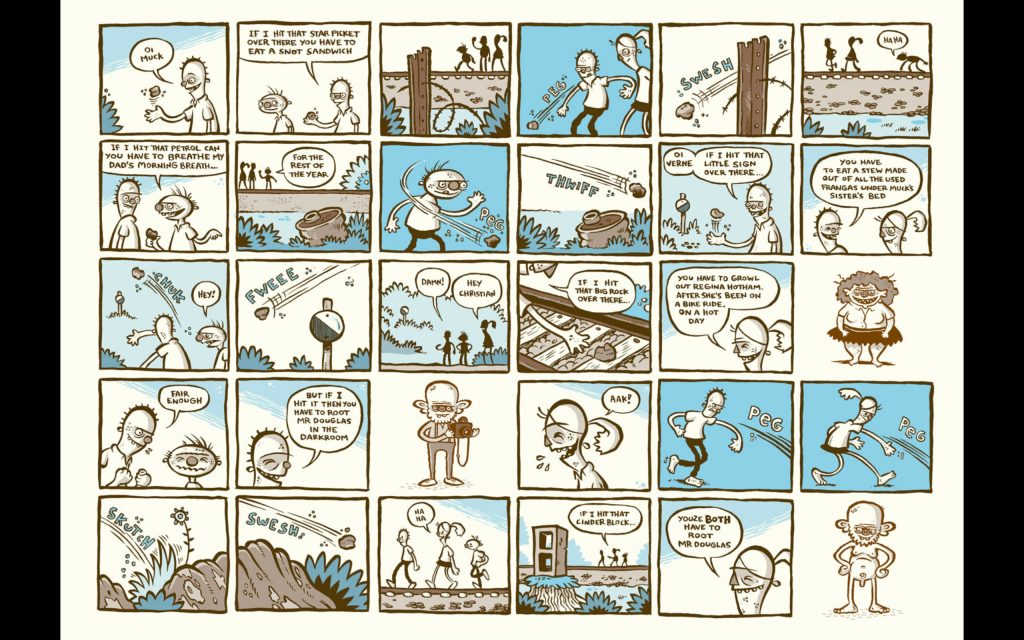by Jo Hoffs

Pat Grant’s Blue is a graphic novel about surfing, about community, about migration and conservatism. First and foremost, it is a story about xenophobia, and about a blue alien race migrating to the fictional town of Bolton. We meet Christian, a Bolton citizen who starts off his story by complaining that the blue aliens “pretty much own the whole town now” (Grant 25). Christian is angry and frustrated – he wants everything to remain the way he knew it from his childhood, a time he spent surfing and having fun with his friends.
Once Christian starts telling the story of how he went looking for a corpse along the train tracks, I was immediately reminded of the novel The Body by Steven King – a similarity which was intended, as Pat Grant explains in an essay at the end. A huge theme in The Body is friendship and finding a sense of belonging somewhere. The four boys in The Body come from difficult family situations where they are either abused or neglected. During their adventure together, they find a sense of community and make some – not always positive – memories. In Blue the feeling of community and friendship also plays a part. Here, it is expressed through one of Pat Grant’s passions: Surfing. Christian, the protagonist of the story, like Geordie from The Body, tells the audience about his youth: A time where he often missed school to go surfing with two of his friends, “the only ones with families lousy enough to let them get away with it” (Grant 38). Christian still longs for this time, because it was a time when there were no blue people in Bolton yet. “You play spot the Aussie around here these days”, he tells the reader. As an introduction to his character, this is perfect because it immediately shows some of his main characteristics: He is a racist middle-aged man missing the days when he was not confronted by the existence of other cultures yet. At the time when Christian and his friends are looking for the body, the blue people have just arrived in Bolton, making it a huge topic of discussion among them. The first time they meet a blue person themselves the friends are already prejudiced wanting the immigrants to go back to “Oogety-Boong Land” (Grant 55).

The allegory of immigrants as a blue alien species in this graphic novel is interesting but at the same time confused me a bit. In my opinion, the political implications weren’t always clear, which doesn’t have to be a bad thing but in a story so heavily focused around a political issue, it weakens the material. On the one hand, the inhabitants of Bolton are biased against the immigrants for xenophobic reasons, as it becomes apparent on page 28, when racist slogans like “we grew here, you flew here” are shown. On the other hand, the blue aliens according to Christian do not take good care of the city, as there is garbage everywhere and the plants are dead (page 25). Without reading the author’s essay at the end, I would not have been sure if this story is actually pro-immigration.


When it comes to the visuals of the story, I like the drawing style and the use of the light blue color in contrast to the black, grey, and sometimes brown colors used for the Bolton natives. Sometimes there are dozens of panels on one page, which gets overwhelming to me personally if there are many word balloons to read (e.g., Grant 58). Another nice touch to the story was the Australian slang words in the dialogue. However, this also complicates the reading experience for those who are not familiar with Australian slang. Footnotes would have been helpful here.
While I enjoyed the story and its different themes – community, racism, generational conflicts, bullying – it left me a bit confused as to what to take away from the story. It feels to me like the author attempted to take the story into multiple interesting directions but failed to properly work out any of them. There is no character development on Christian’s part, no other characters to give some kind of a satisfying conclusion and especially, there is not much of a take-away from the story. Nevertheless, I would recommend this graphic novel, as I think it’s possible to have many different views on it and speaking from experience, every re-read helps you discover new aspects.
Works Cited
Grant, Pat. Blue. Top Shelf, 2013.


